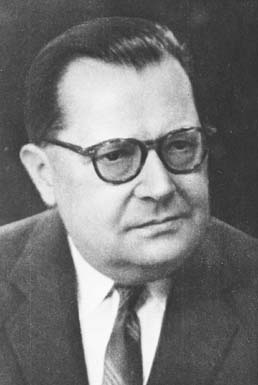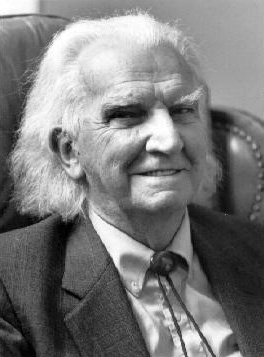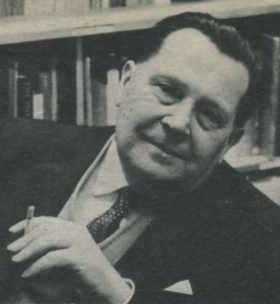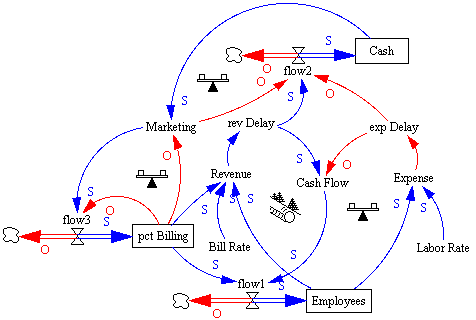Contents |
Overview

Contemporary ideas from systems theory have grown with diversified areas, exemplified by the work of Béla H. Bánáthy, ecological systems with Howard T. Odum, Eugene Odum and Fritjof Capra, organizational theory and management with individuals such as Peter Senge, interdisciplinary study with areas like Human Resource Development from the work of Richard A. Swanson, and insights from educators such as Debora Hammond and Alfonso Montuori. As a transdisciplinary, interdisciplinary and multiperspectival domain, the area brings together principles and concepts from ontology, philosophy of science, physics, computer science, biology, and engineering as well as geography, sociology, political science, psychotherapy (within family systems therapy) and economics among others. Systems theory thus serves as a bridge for interdisciplinary dialogue between autonomous areas of study as well as within the area of systems science itself.
In this respect, with the possibility of misinterpretations, von Bertalanffy [1] believed a general theory of systems "should be an important regulative device in science," to guard against superficial analogies that "are useless in science and harmful in their practical consequences." Others remain closer to the direct systems concepts developed by the original theorists. For example, Ilya Prigogine, of the Center for Complex Quantum Systems at the University of Texas, Austin, has studied emergent properties, suggesting that they offer analogues for living systems. The theories of autopoiesis of Francisco Varela and Humberto Maturana are a further development in this field. Important names in contemporary systems science include Russell Ackoff, Béla H. Bánáthy, Anthony Stafford Beer, Peter Checkland, Robert L. Flood, Fritjof Capra, Michael C. Jackson, Edgar Morin and Werner Ulrich, among others.
]]> Note
NoteLudwig von Bertalanffy (1901-1972) has been on of the most acute minds of the XX. century. Here is a miscellanea of passages from his General System Theory. The first part of the text focuses on the function of the theory of systems and on the main features of closed and open systems. The second part presents a conception of the human being not as a robot or a moron aiming at reducing tensions by satisfying biological needs, but as an active personality system creating his own universe, who revels in accepting challenges, solving problems and expressing his artistic inclinations.
The Quest for a General System Theory
There exist models, principles, and laws that apply to generalized systems or their subclasses, irrespective of their particular kind, the nature of their component elements, and the relation or 'forces' between them. It seems legitimate to ask for a theory, not of systems of a more or less special kind, but of universal principles applying to systems in general.
In this way we postulate a new discipline called General System Theory. Its subject matter is the formulation and derivation of those principles which are valid for 'systems' in general.
A consequence of the existence of general system properties is the appearance of structural similarities or isomorphisms in different fields. There are correspondences in the principles that govern the behaviour of entities that are, intrinsically, widely different. To take a simple example, an exponential law of growth applies to certain bacterial cells, to populations of bacteria, of animals or humans, and to the progress of scientific research measured by the number of publications in genetics or science in general.
System isomorphisms also appear in problems which are recalcitrant to quantitative analysis but are nevertheless of great intrinsic interest. There are, for example, isomorphies between biological systems and 'epiorganisms' like animal communities and human societies.
]]> Note
NoteIt presents an interesting classification of levels of systems and it elaborates on the vastness of the work that waits us if we want to push forward the scientific endeavour. For that we need not only the General Systems Theory but also a series of new concepts more capable of presenting reality in its full complexity.
This paper was written especially for Management Science, 2, 3 (Apr. 1956) pp.197-208 and was reprinted in General Systems, Yearbook of the Society for General Systems Research, vol. 1, 1956.
General Systems Theory is a name which has come into use to describe a level of theoretical model-building which lies somewhere between the highly generalized constructions of pure mathematics and the specific theories of the specialized disciplines. Mathematics attempts to organize highly general relationships into a coherent system, a system however which does not have any necessary connections with the "real" world around us. It studies all thinkable relationships abstracted from any concrete situation or body of empirical knowledge. It is not even confined to "quantitative" relationships narrowly defined - indeed, the developments of a mathematics of quality and structure is already on the way, even though it is not as far advanced as the "classical" mathematics of quantity and number. Nevertheless because in a sense mathematics contains all theories it contains none; it is the language of theory but it does not give us the content.
At the other extreme we have the separate' disciplines and sciences, with their separate bodies of theory. Each discipline corresponds to a certain segment of the empirical world, and each develops theories which have particular applicability to its own empirical segment. Physics, chemistry, biology, psychology, sociology, economics and so on all carve out for themselves certain elements of the experience of man and develop theories and patterns of activity (research) which yield satisfaction in understanding, and which are appropriate to their special segments.
]]>
Complex systems is the subject of a diverse variety of sciences and professional practice methods. It is often overshadowed by the representation of the natural organization with systems of equations, the main subject below. In the study of complex systems that are less usefully represented with equations various other kinds of narratives and methods for identifying, boundaries, exploring, designing and interacting with complex systems are used. A more broad view of the various disciplines and practice methodologies using the complex systems approach is found on the Encyclopedia of the Earth.[1]
The equations from which complex system models are developed generally derive from statistical physics, information theory and non-linear dynamics, and represent organized but unpredictable behaviors of systems of nature that are considered fundamentally complex. The physical manifestations of such systems cannot be defined, so the usual choice is to refer to "the system" as the mathematical information model, without referring to the undefined physical subject the model represents. One of a variety of journals using this approach to complexity is Complex Systems.
Such systems are used to model processes in computer science, biology[2], economics, physics and many other fields. It is also called complex systems theory, complexity science, study of complex systems, sciences of complexity, non-equilibrium physics, and historical physics. A variety of abstract theoretical complex systems is studied as a field of mathematics.
The key problems of complex systems are difficulties with their formal modeling and simulation. From such a perspective, in different research contexts complex systems are defined on the basis of their different attributes. Since all complex systems have many interconnected components, the science of networks and network theory are important aspects of the study of complex systems. A consensus regarding a single universal definition of complex system does not yet exist.
]]> Strategists derive further insights into the affect of trends and possible future scenarios when examining the components of the external environment using von Bertalanffy's "General Systems Theory". There is a deeper understanding of the inter-relatedness of the influencing factors in the environment when applying systems theory to the strategic planning model. This approach produces a richer, and thus better, appreciation of the sub-systems that compose the larger synergistic general system that is our global total system. The addition of von Bertalanffy's systems theory perspective to the strategic scanning of the future to 2050 seems practical and wise.
Strategists derive further insights into the affect of trends and possible future scenarios when examining the components of the external environment using von Bertalanffy's "General Systems Theory". There is a deeper understanding of the inter-relatedness of the influencing factors in the environment when applying systems theory to the strategic planning model. This approach produces a richer, and thus better, appreciation of the sub-systems that compose the larger synergistic general system that is our global total system. The addition of von Bertalanffy's systems theory perspective to the strategic scanning of the future to 2050 seems practical and wise.
"Tomorrow always arrives; the wise seek knowledge to prepare!" - Anonymous
Strategists perform environmental scanning by monitoring the globe for future opportunities and threats that will affect their organizations. The external environment is generally beyond the control of any organization and includes the following categories: the competition, the economy, social-cultural-demographic factors, political-legal-governmental aspects, technology, and the natural environment. Each of these categories is a sub-system of a larger system, when systems theory explains the strategic planning model. Therefore, this paper's thesis is that an understanding of general systems theory provides an enhanced appreciation of how each of these sub-systems interconnects and interacts. In addition, by using this conceptual approach, one may understand more deeply trends and the critical nature of the interplay between these various components.
"Japan Inc." is now strategically planning for the year 2025. Chinese strategic planners are projecting 2150. Recently, the Central Intelligence Agency (CIA) uncharacteristically released an unclassified document entitled, Global Trends 2015, for rare public consumption (Global Trends 2015, published by the CIA, 2001).1 Other respected sources, Which World?: Scenarios for the 21st Century, present similar trends and forecast through 2050 (Which World?: Scenarios for the 21st Century, published by California Institute of Technology, 2001).2 Using the lens of systems theory, we may see how trends and likely scenarios of the future global environment between 2015 and 2050 are connected. According to systems theory, a sub-system or trend is conceptually not in isolation of the global total system.
]]>Mutual Causality in Buddhism and General Systems Theory: The Dharma of Natural System (Buddhist Studies Series) (Paperback)
By: Joanna R. MacY (Author)
ISBN: 0791406377
Publisher: State Univ of New York Pr
Unlike traditional languages, the Universal Systems Language (USL) is based on a preventative instead of a curative paradigm.[1][2][3][4] Based on systems theory, to a great extent derived from lessons learned from the Apollo onboard flight software effort, USL has evolved over several decades and taken on multiple dimensions as a Systems Engineering approach.
According to its users, USL eliminates any preconceived notions because it is a world unto itself–a completely different way to think about systems. Instead of object-oriented and model-driven systems, the designer thinks in terms of system-oriented objects (SOOs) and system-driven models. Much of what seems counterintuitive with traditional approaches, which tend to be software-centric, becomes intuitive with this systems-centric approach.
USL was created for designing systems with significantly increased reliability, higher productivity, and lower risk. It was designed with the following objectives in mind:
- reduce complexity and bring clarity into the thinking process;
- ensure correctness by inherent, universal, built-in language properties;
- ensure seamless integration from systems to software;
- ensure traceability and evolvability,
- develop unambiguous requirements, specifications, and design;
- ensure that there are no interface errors in a system design and its derivatives;
- maximize inherent reuse;
- ensure that every model captures real-time execution semantics (for example, asynchronous and distributed);
- establish automatic generation of much of design, reducing the need for designers’ involvement in implementation details;
- establish automatic generation of 100 percent, fully production-ready code, from system specifications, for any kind or size of software application; and
- eliminate the need for a high percentage of testing without compromising reliability.
USL together with its automation[5], can address these objectives because of the systems theory that forms its foundations. It also takes roots from other sources–other real-world systems and formal linguistics, methods, and object technologies.
]]> Systems Thinking has been defined as an approach to problem solving, by viewing "problems" as parts of an overall system, rather than reacting to specific part, outcomes or events and potentially contributing to further development of unintended consequences. Systems thinking is not one thing but a set of habits or practices [1] within a framework that is based on the belief that the component parts of a system can best be understood in the context of relationships with each other and with other systems, rather than in isolation. Systems thinking focuses on cyclical rather than linear cause and effect.
Systems Thinking has been defined as an approach to problem solving, by viewing "problems" as parts of an overall system, rather than reacting to specific part, outcomes or events and potentially contributing to further development of unintended consequences. Systems thinking is not one thing but a set of habits or practices [1] within a framework that is based on the belief that the component parts of a system can best be understood in the context of relationships with each other and with other systems, rather than in isolation. Systems thinking focuses on cyclical rather than linear cause and effect.
In science systems, it is argued that the only way to fully understand why a problem or element occurs and persists is to understand the parts in relation to the whole.[2] Standing in contrast to Descartes's scientific reductionism and philosophical analysis, it proposes to view systems in a holistic manner. Consistent with systems philosophy, systems thinking concerns an understanding of a system by examining the linkages and interactions between the elements that compose the entirety of the system.
Science systems thinking attempts to illustrate that events are separated by distance and time and that small catalytic events can cause large changes in complex systems. Acknowledging that an improvement in one area of a system can adversely affect another area of the system, it promotes organizational communication at all levels in order to avoid the silo effect. Systems thinking techniques may be used to study any kind of system — natural, scientific, engineered, human, or conceptual.
]]>What Systems Theory is Not
The definition of Social Systems theory must not be confused with another theory known as “reductionism” (Koestler, Smithies, 1969 p. 60). Reductionism is a term introduced by Rene Descartes in the 1600’s which, contrary to the systems theory, offers that all things, no matter how complex they are, operate thanks to very basic units. Though the idea of smaller parts forming a complex organism is shared in both theories, reductionism differs from systems theory in that it tends to minimize the complex by focusing on how simple its parts are. (Descartes, 1637)
Systems theory does the opposite: It gives emphasis to the complexity that exists within the elements of a whole and tries to understand the dynamics that occur among such formative elements (Von Bertalanffy, 1964 p. 62)
It is safe to assume that every formative process seems to follow the same pattern of behavior: Individual parts joining together to make a whole part which may, or may not resemble the elements that built it. Yet, what motivates the individual parts to unite? How do the parts of an object interact? How do the changes within the parts affect the changes within the system? Those questions are what bring us to the analysis of four sociologists: Von Bertalaffy, Banathy, and Laszlo.
Ludwig Von Bertalanffy
Von Bertalanffy saw the world through scientific eyes (Brauckmann, 1999). As a scientist, he had already conceived a series of theories that aimed to show a structure and pattern of formation among different things. In 1930 he offered the “Organismic Systems Theory” (Von Bertalanffy, 1960, p. 156). This theory attempted to explain the processes of life as a phenomenon. He insisted that individuals exist because of a combination of different processes that work together in the formation of the organism. He offered that these processes are systemic, yet dynamic, and complex. To illustrate this idea, Von Bertalanffy compared the organism as a machinery out in the open trying to “maintain equilibrium”. This equilibrium symbolized the individual’s struggles to survive and adapt to an environment, but also the internal struggles to adapt and perform that occur within the systems that compose the individual itself (Von Bertalanffy, 1960, p. 158-159).
The Organismic Systems Theory gave life to a myriad of other theories proposed by Von Bertalanffy to explain the processes of unification. However, it was the General Systems Theory (GST) what seemed to encompass his entire model in a transdisciplinary way. The GST is defined as a “metatheory” that arose from the previous postulates by Bertalanffy. (Braukmann, 1999, p. 2)
]]>